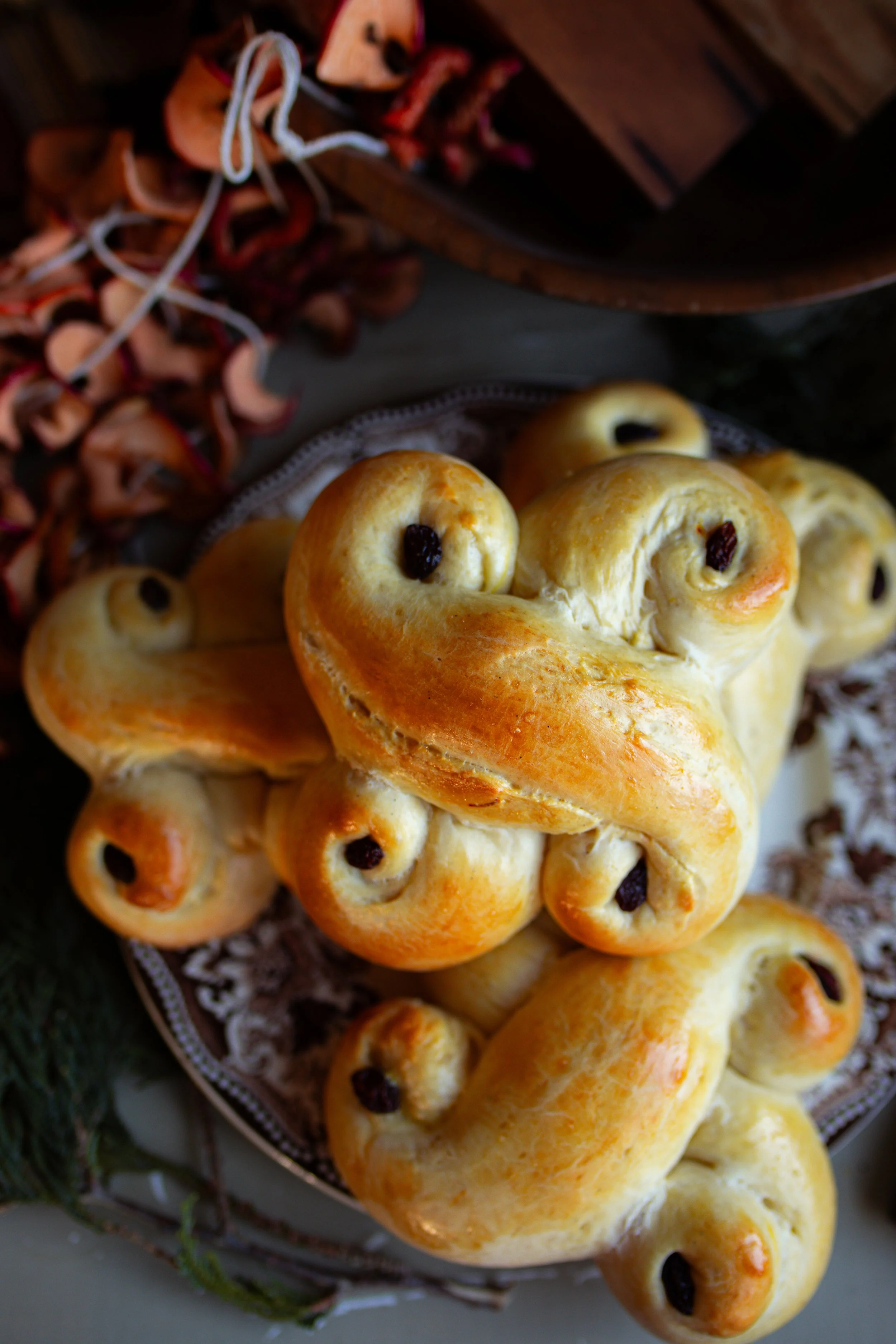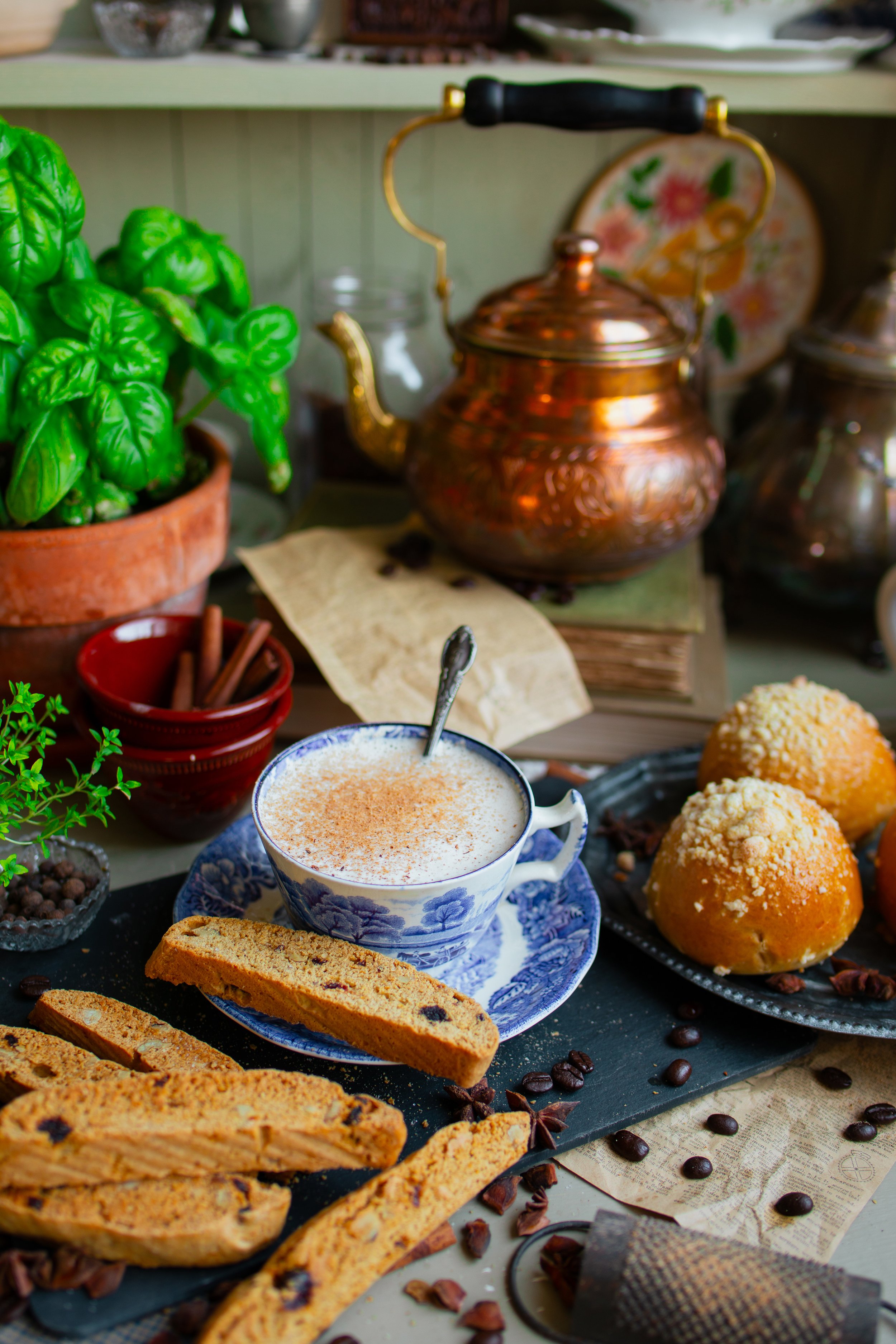St. Lucia Buns from Kirsten’s World: American Girl Recipes
Today is December 13th, the day that once marked the winter solstice on the old Julian calendar. On this day, it is a tradition across Scandinavia to celebrate St. Lucia’s Day and make St. Lucia Buns, or a beautiful spiraled sweet bun enhanced with saffron.
These buns have been made for thousands of years with debated origins and much history attached to them. The buns in this post are inspired after my most recent project, recreating and adapting the recipes from my American Girl Cook Books. In this post, I will be sharing an adaptation of the recipe from Kirsten’s Cook Book. These buns are sweet and fluffy. They make a perfectly delicious breakfast to enjoy with coffee, just as Kirsten and her family did in 1854!
kirsten’s st. lucia day:
Kirsten is a Swedish immigrant who settles in Minnesota in 1854. During their first winter and Christmas holiday in their new home, Kirsten surprises the family by dressing up in her St. Lucia costume, a white robe, red sash, and a candle-lined wreath crown.
It is tradition for the eldest daughter to serve her parents with the baked saffron buns and hot coffee, bringing the tray around early in the morning before the first light comes up. December 13th once marked the winter solstice, the longest night of the year, though today we observe the solstice on December 21st or 22nd.
Saint Lucia by Francesco del Cossa; 1472
origins of st. lucia day:
St. Lucia Day is celebrated in Sweden, Denmark, Norway, and Finland. It pays tribute to St. Lucia, a Christian martyr who died in the fourth century. The red sash is a symbol of her martyrdom and the candle-lined wreath crown represents how she lit the darkness in the Roman catacombs to deliver food to those in hiding.
However, this is debated by historians as there is evidence of the St. Lucia Buns being recorded even earlier than St. Lucia’s story takes place. It is a long-held folk belief in Scandinavia that the buns were a sacrifice to demons and goblins who would roam free on their “Wild Hunt” during the longest night. The name of the buns, lussekatter or “Lucy’s cats”, derives from the original doveskatter or “devil’s cats,” and this term comes from a Dutch bread called duivekater.
This was served at pagan midwinter feasts. These buns are shaped very similarly to pagan sun bread, and they can be seen in the evidence of written receipts and paintings. It is also believed that the bread may be called this as it looks like a curled up cat sleeping, with the dried fruit representing the eyes.
Saint Lucia Day Buns Shapes by Johanna Kindvall
different bun shapes:
St. Lucia Buns actually come in various shapes, which can range from simple to complicated. For the buns that I made, I chose to go along with the shape represented in Kirsten’s Cook Book. These buns were also made into an accessory for the Kirsten American Girl doll as the Saint Lucia Tray, and you can still find them through sellers on Etsy or Ebay.
The shape from Kirsten’s book is called gull vagn or “the golden wagon” and can be made with the spirals all facing in one direction or facing outward from the center. Other shapes are jul galt or lussegalt "(The Christmas Pig or Lucy’s Pigs), jul kuse (Christmas horse), lyran (the lyre), or linde harnet (the little baby).
how to shape the buns:
Begin by dividing the dough into 12 equal sized pieces. With 2 of the pieces, roll them out into 10-inch (25-cm) long snakes.
Cross the 2 pieces of dough over each other, forming the shape of a cross.
With one end of the dough, begin rolling it towards the center of the cross, like a snail or a spiral shape. Repeat this process with the remaining ends of the dough until it looks like a spiraled sun.
final thoughts:
As always, it was a lovely little rabbit hole to go to down to learn more about the origins of this Swedish tradition! Now that I am older and know more about my own family’s history, I can’t help but feel a connection to Kirsten and her family’s story even though it is a fictional one. It was not fictional for many Scandinavian immigrants who came to the United States to rebuild their lives, just like my own family who traveled from Norway, Sweden, and Denmark to live in the west.
I hope that you enjoyed learning more about St. Lucia Buns and my little American Girl series! These buns are truly so delicious, and I hope that you have a chance to give them a try.
xoxo Kayla
St. Lucia Buns (Lussekatter) from Kirsten's World: American Girl Recipes
Ingredients
- 1 cup (240 ml) milk
- 1/2 cup (116 g) salted butter
- 1/3 cup (66 g) granulated sugar
- 4 1/2 cups (585 g) all-purpose flour
- 1 tbsp (12 g)
- 1 1/2 tsp kosher salt
- 1/4 tsp saffron threads
- 2 large eggs
- 1 tsp vanilla extract
- 1 large egg + 1 tbsp (15 ml) water, for egg wash
- Raisins, for decorating
Instructions
- In a small saucepan, warm the milk, butter, and sugar together until the milk just turns hot to the touch. Let this rest for about 10 to 15 minutes, letting the butter melt almost completely in the milk.
- In the bowl of a standing electric mixer fitted with a hook attachment, combine 2 cups (260 g) of the flour, the yeast, the salt, and the saffron. Pour in the warm milk mixture and turn the mixer on medium speed. Once all of the flour has been absorbed the liquid, begin adding the remaining flour about 1 cup (130 g) at a time until a smooth dough forms that no longer clings to the sides of the bowl. Knead the dough for about 10 minutes before shaping into a ball and placing in a large lightly greased bowl.
- Cover the bowl with plastic wrap or a damp tea towel and let rise until doubled, about 1 to 1 1/2 hours.
- After the dough has finished rising, gently deflate the dough. Divide the dough into 12 equal sized pieces.
- Set aside a lightly greased baking sheet. With 2 pieces of dough, roll them out with your hands into 10-inch (25-cm) long ropes. Cross the ropes over each other, like a cross. Then, with the end of one rope, roll it towards the center of the cross, making a snail shape or spiral. Repeat this with the other four ends until it looks like a bit like a spiraled sun.
- Place the finished bun on the baking sheet. Cover it with plastic wrap and repeat the process with the remaining pieces of dough until you have 6 finished buns. Let them rise, covered, until nearly doubled, about 30 to 45 minutes.
- Preheat the oven to 350° (177° C). In a small dish, combine the egg and water to create the egg wash. Brush the egg wash all over the puffed buns. Then, place a raisin in the center of each spiral, pressing it down gently.
- Bake the buns for 20 minutes or until they are a deep golden yellow and cooked through the center. Let them rest for about 30 minutes before eating, if you can wait!
more posts you may enjoy!
This post contains affiliate links that I may earn a small commission from.
sources
Detangling the Devilish Origins of Scandinavia’s St. Lucia Buns, Sam O’Brien



















